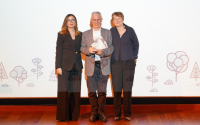13 January 2008
Rat hearts, stripped of their cells by detergents, have been used as a scaffold to engineer a bioartificial heart, which can amazingly pump a little like the original organ.
With further development, the method may one day be used to repair heart damage or even generate new hearts for transplantation. Cell-free hearts from pigs, for example, could serve as scaffolding to grow a heart with human cells, researchers say, because pig hearts are of a similar size and complexity to human hearts.
The heart has 3 billion cells that beat in synchronization to pump more than 7,500 litres of blood each day through 100,000 miles of blood vessels. It is a marvel of engineering, but it is also notoriously poor at repairing itself.
Worldwide, 22 million people live with heart troubles, and researchers have been hunting for ways to heal cardiac tissue. Some have tried injecting cardiac stem cells directly into the site of damage (see "Cells mend damaged mouse hearts"). Others have engineered small sheets of tissue that can patch damaged regions of the heart.
But the size of those cardiac patches has been limited. Although existing blood vessels may feed thin slices of tissue, they are unable to sustain thick patches or complex structures.
“It’s a long way to go before you can regenerate the heart,” says Gordana Vunjak-Novakovic, a bioengineer at Columbia University in New York. “It’s just too complex.” Finding a scaffold that could support regeneration would solve a key problem in the field, she says.
From little seeds
Doris Taylor, a bioengineer at the University of Minnesota in Minneapolis, and her colleagues decided that rather than manufacturing a scaffold they would get one from nature. They pumped detergent through the vasculature of rat hearts, stripping away the cells. Twelve hours later, the cells were gone, leaving behind blood vessels embedded in a mixture of collagen and other compounds that comprise the 'extracellular matrix'.
“If you think about a steak, it’s the gristle. It’s the stuff underneath the cells that holds the cells together,” says Taylor. “It looks like a ghost heart. And it feels a little like jello.” The gelatinous structure was found to have mechanical properties similar to an intact heart, including its ability to spring back after stretching.
Taylor and her colleagues maintained the ghost heart in a special bioreactor, and then 'reseeded' it by injecting it with heart cells from newborn mice. The transplanted cells re-lined the blood vessels and, three days later, began to beat with tiny, microscopic contractions in response to an electrical current.
A few days after that, the contractions were visible to the naked eye and the heart was pumping at 2% of its normal function. The results are published today in Nature Medicine 1.
Pump it
Two percent may seem small, but it is a significant achievement, observers say. “The fact that there is any contractile function after going through what this thing went through is pretty amazing,” says Joseph Vacanti, a surgeon and tissue engineer at Massachusetts General Hospital in Boston who was not affiliated with the work.
Vacanti notes that getting heart function above just 10% would be an improvement for some patients. Meanwhile, Taylor says there is plenty of room for improvement in the ghost-heart method. “We haven’t tried to push the system yet,” says Taylor. “We wanted to see if this was just some crazy idea.”
Some ‘decellularized’ products are already used in humans. Pig heart valves, for example, are transplanted into people after first being cleaned of their cells. “It’s less bizarre than it may look at first,” says Vunjak-Novakovic.
Bare brains
Taylor and her collaborators have also applied the technique to mammalian muscle, livers, kidneys and lungs, all with promising results, she says. “The only organ that we’ve come across that doesn’t seem amenable to this is the brain,” says Taylor. “It turned more to mush and did not hold up as well.”
It isn’t yet known if donor scaffolds will be accepted by the patient’s immune system, but if cells used to re-seed the heart can be taken from the recipient, the odds of rejection may be diminished. It is also possible, adds Vacanti, that those host cells would gradually replace the foreign extracellular matrix with their own material.
“It sounds like science fiction,” says Taylor. “But then in retrospect, you think, ‘duh. It’s kind of simple’.”
References
Ott, H. C. et al. Nature Med. advance online publication doi:10.1038/nm1684 (2008).http://www.nature.com/news/2008/080113/full/news.2008.435.html






